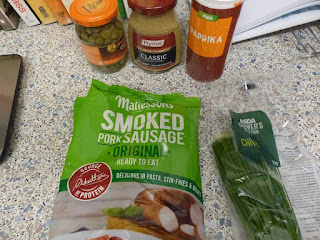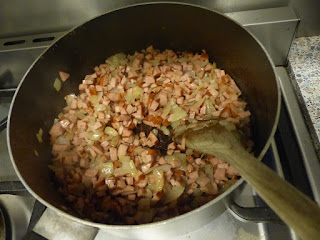Ah, June. The European football championships are in full flow, the sun is occasionally shining between torrential rainstorms, and our landlords have informed us that they're selling up so we need to find somewhere new to live. A pain in the arse generally, but not the worst thing as far as my culinary output is concerned - my library could generally use a good sort-out, and to be perfectly honest, there are some cookbooks that probably won't be making the journey to the new house.
As if they know their days are numbered, two of them duly pop up in this month's random selection. (The third one is the Ottolenghi, and that one is staying, obviously.) Let's see if they make the most of their next-to-last chance at salvation, shall we?
◘ THE STARTER ◘
The book: Everyday Novelli (Jean-Christophe Novelli)
The recipe: p228, "Rémoulade"
Yes, just "Rémoulade". I was all set to spin the wheel again, because remoulade (soz, French folks, I can't be bothered to do the accent every time) is just a sauce, and my Random rule is that I skip things that are sauces, condiments, or not really recipes in their own right. But on further reading, what Novelli means here is celeriac remoulade, which - as you might know (I didn't) - French cuisine considers to be one of the classic uses for remoulade and, indeed, perhaps the classic use for celeriac.
I'm not averse to finding something to actually do with celeriac, since (beyond mash and soup) I'm always at a bit of a loss when it occasionally turns up in our veg box, though I'm not hugely enthused by something that basically looks like "posh coleslaw". Still, no less an authority than Mary Berry assures me that celeriac remoulade constitutes a salad in its own right and is "perfect as a side dish or with some leaves for a healthy light lunch", making it sufficiently substantial to qualify as this month's first course. Besides, I've been known to spread spicy ajvar on toast, spoon over some coleslaw and call that an adequate lunch, so I'm hardly in a position to argue.
With only five ingredients, I figure we're unlikely to run into any issues here, but it turns out that late June is not the time to source a celeriac in a Lewisham supermarket. The veg box company have also categorised it as firmly out of season, and I'm all set to either spin the wheel again or look into potential alternatives (turnip with some added celery salt? The internet is amazing) when inspiration strikes. Well, not so much inspiration as a happy accident: In the process of using a rare venture into central London as an opportunity to pop into Scandinavian Kitchen for some herring and foam cars, I realise I'm not far from the Waitrose food hall on Oxford Street. If anywhere can come up trumps, it's that bastion of middle-class consumption. Et voilà! The last celeriac in the shop is mine, and for a bargaintastic 68p.
 |
| Lovely jubbly |
Once I'm back home and I've already eaten half of the foam cars, I cut the celeriac into matchstick-sized pieces* and toss it in lemon juice to stop it from browning. Every recipe seems to suggest using a mandolin to achieve the necessary julienne-style slices with minimal fuss, but I'm not getting one of those for the two or three times a year I might actually need one, so a paring knife it is. This does mean the pieces aren't as small as they probably ought to be, but I'm not afraid of a bit of crunch.
 |
| *ish |
Next it's time to prepare the sauce or dressing or whatever you want to call it - the actual remoulade, in other words. Novelli's version involves wholegrain mustard, horseradish, mayonnaise, and salt and pepper. You can imagine what that looks like, but here it is anyway:
This then gets combined with the celeriac strips and we're done. Well, the blurb did say this was quick.
For all the insistence that this could constitute a light meal in its own right, I feel it's far too plain for that. Interpreting it as more of an accompaniment, I serve it on the side of a blinged-up burger and some sweet potato fries - essentially in lieu of coleslaw - and in that context it actually works rather well, giving a sharpness and punch in opposition to the fattiness of the rest of the plate.
There's absolutely loads left over, so the next few days see me experimenting with lunch options, and actually... as much as it pains me to say it, Mary Berry isn't so wrong. I should add that I don't so much serve it "with some leaves" as "in a dollop on top of a whole plate of salad", but in that context, essentially serving as a kind of crunchy mayonnaise with a kick of heat, it's a good fit.
I'm not sure I'd go out of my way to make it again, especially since Novelli warns that it has a fridge life of a mere "2-3 days", but it's certainly an option the next time a celeriac lands on my doorstep. (Not literally - we'd have moved house a lot sooner if that kind of thing kept happening.)
One-word verdict: Crunchy.
◘ THE MAIN COURSE ◘
The book: Jerusalem (Yotam Ottolenghi and Sami Tamimi)
The recipe: p238, "Marinated Sweet and Sour Fish"; p120, "Mejadra"
The fish is the random choice here, the mejadra rice being my chosen accompaniment - I've made it before so I know it goes well with most things. It's basically a rice and lentil dish...
 |
| A modest serving |
...combined with tons of deep-fried onions.
 |
| This is about a quarter of what goes into the final dish |
Carbs and oil, what's not to like?
There's the added perk that mejadra is "best served warm but is also fine at room temperature", which is another reason I choose it as a pairing here - because, as counterintuitive as it might sound, Ottolenghi's sweet and sour fish is also a room temperature dish. Indeed, the recipe actively suggests preparing it in advance and marinating it for a day or two in the fridge before bringing it back to room temperature to serve. Sounds like a bit of a faff in principle, but it suits my food planning for this particular week quite nicely, so why not.
The pre-marinating phase involves two processes that take place in parallel. One is dipping some salted white fish in flour then egg, then frying it for three minutes or so before drying it on a paper towel to soak up the excess oil. I'm surprised and pleased that pollock is the suggested fish here, since it's the British supermarket go-to "white fish that's cheaper than cod", and hence locating some proves unproblematic - though I do have to settle for frozen, which I'm aware (from bitter experience) will make the fish more likely to flake and crumble once cooked. As we can already see here:
Still, going by the rest of the dish, a bit of mess won't be an issue. The concurrent process involves - in separate, defined steps - frying some onions and coriander seeds, then adding one red pepper and one yellow pepper, sliced into 1cm slices. After cooking this for a while, some garlic, bay leaves, curry powder and chopped tomatoes are added. Some minutes later, sugar, cider vinegar, salt and black pepper join the mix, and this is left to bubble for a further five minutes. Given that the whole thing is going to sit in the fridge for a couple of days anyway, it feels a bit laborious to be doing all of this separately rather than in one go, but either way, it isn't difficult, even if the result is... not especially appealing.
 |
| Not helped by decidedly average photography |
Anyway, I then make space in this dish to carefully add the fish, as well as some water so that the fish is fully immersed in the vegetables and liquid. This then goes into a hot oven for 10-12 minutes - I did say this was a bit laborious - before being brought out to return to room temperature ahead of going into the fridge to marinate.
When it comes out two days later, it looks every bit as attractive as you'd expect of some white fish that's soaked up a bunch of other stuff.
 |
| Yikes |
And indeed, as I confidently predicted, the fish has duly flaked and disintegrated even more than it already had before going into the pot.
As such, even with the addition of some hearty mejadra, this plate would not be destined for Instagram if it wasn't for this blog requiring it.
 |
| Almost looks like a Chinese takeaway, actually |
Still, the flavour is what counts - and this is quite decent! "Sweet and sour" is one of those phrases that really could mean anything, from evil gloopy jar-based sauce to whatever this pseudo-satay concoction was all about. In this case, however - as the ingredients detailed above suggest - it's mainly about the pairing of tangy vinegar and peppers with warming coriander and curry powder. I don't feel like the fish has especially taken on much of that, which is a bit surprising since that's surely the point of the extensive marinating time, but the flavours around the fish are tasty (and an awful lot better than the dish looks).
So while I'm not sure it's quite what I expected (I suppose using fish that actually holds its shape might have helped), I'm not dissatisfied with this. I'm not convinced it's entirely worth the time commitment, even if none of the steps are especially arduous, and I'd be interested to see what it's like as a hot dish, served up straight from the oven, and whether the flavour profile is really all that different. I might give it a try some time. Then again, maybe I won't.
One-word verdict: Acceptable.
◘ THE DESSERT ◘
The book: How To Cheat At Cooking (Delia Smith)
The recipe: p214, "Lemon Meringue Pie"
Yes, the random finger of fate has decided that it's already time to give Delia the opportunity to atone for the fairly pointless "Eton Mess" she foisted on us in March.
This take on lemon meringue pie is even odder than most of the recipes in How To Cheat At Cooking, because it involves baking the lemon tart from the recipe further up the same page, leaving it to cool, then making some meringue and baking it some more. I'm no expert but that feels like it's... both lazy and too much effort simultaneously? Still, the recipe is the recipe, so let's see what Delia has in store for us.
The shortcuts this time involve a store-bought sweet pastry case - no arguments here - and, erm, a jar of lemon curd as the filling. Well, OK - it's not just lemon curd, I'll be making a few additions too, but still. The primary ingredient will be lemon curd, and that's not quite the same thing as what normally goes into a lemon meringue pie, is it?
 |
| [foreboding intensifies] |
The additions in question are the zest and juice of a large lemon, a beaten egg, and two tablespoons of half-fat crème fraîche. These get stirred into the jar's worth of lemon curd, and that's the preparation already done.
I'm worried that the pastry case is already dangerously full here, since the egg has presumably been added to help the filling expand and set as it cooks. Turns out I needn't have worried, because the required 20-25 minutes at 170°C does very little to make the filling actually set.
 |
| Also note slight seepage at the edges. What was that about foreboding? |
Striking a balance between the recipe and reality, I leave the tart in the oven as it cools, which helps to firm things up a little (though not much). After that, I leave it on the side to cool properly "for 1 hour" before it's time to heat the oven a second time while I whip up some meringue. This is straightforward enough - three egg whites and some caster sugar - and it comes out nicely given that I have a slightly patchy history with meringue,
This gets spread across the top of the tart, then the whole thing goes into the oven at 170°C "for 10-12 minutes or until the meringue is a pale biscuit colour".
I take it out after 10-12 minutes and, well. Not only is that a bloody pale biscuit, but when I try and move the pie to judge whether it's sufficiently set or not, this happens:
Now, I have to admit this isn't all Delia's fault; it seems like my pie case had a weak point or two in it to begin with, although I'd argue the baking process has intensified the issue (and double-baking it probably even more so).
 |
| Seepage |
Anyway, since the meringue clearly needs a lot longer than those 10-12 minutes in the oven to be done, I put the pie back in for a while and hope that this might firm up the filling enough to make it servable when it all cools down.
I'm actually reasonably happy with it when it comes back out, except now the filling has finally expanded a little, leaving a weird disconnect between the pie and the meringue topping.
Would this be avoided by doing it all in one go like in a normal recipe? Maybe it would; I've actually never made a lemon meringue pie before, so I have no way of comparing.
"Leave to cool before serving" is the final instruction from Delia. On this particular day, and with the time and hassle of having had to twice-bake the thing, the pie is actually still a bit warm when we do get round to trying it.
 |
| Elegant |
That might help to explain why it's not a great eating experience. As expected, the modified lemon curd filling isn't really right for the purpose - it's too rich and sugary and sticky, and not at all refreshing like you'd want a citrus dessert to be. Admittedly, a portion of that refreshment comes from it being cool/chilled - you don't encounter many warm lemon desserts (though I'm sure there are some) - but still, the objective is for the lemon flavour to cut through the gloopy sugary meringue, and here it really doesn't.
However... served from the fridge a day later, it works a lot better. The filling and the meringue have properly set now, in a way they wouldn't have done even if they'd had the time to cool to room temperature like Delia wanted, and the different elements of the dish - crust, filling, topping - are more distinct and do what they're actually supposed to. The filling is still too rich really, but it just about gets away with it now. Not quite a victory snatched from the jaws of defeat, but a scrappy 0-0 draw, at least.
The "cheats" here are mostly pointless, though, and that ultimately condemns the concept to failure as far as I'm concerned. Baking the pie in two phases makes no real sense and just wastes valuable time and oven heat. And given that it risks actively torpedoing the whole thing, I can't say that the lemon curd filling justifies the ease of not simply making your own.
The pre-made pastry case, though? That's fine. Just, you know, check it for cracks first
Two-word verdict: Okay, eventually.























 No need for smoke and mirrors this month: I really do make all three of these dishes on the same day and serve them as part of the same (extended) meal. A true Random Menu for once!
No need for smoke and mirrors this month: I really do make all three of these dishes on the same day and serve them as part of the same (extended) meal. A true Random Menu for once!

























